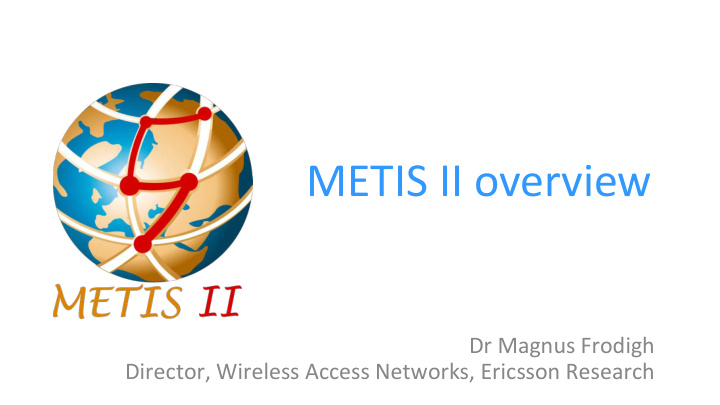



METIS II overview Dr Magnus Frodigh Dr Magnus Frodigh Director, Wireless Access Networks, Ericsson Research Director, Wireless Access Networks, Ericsson Research
METIS-II objectives Develop the overall 5G radio access network design 1 Special focus on pre-standardization Provide the 5G collaboration framework within 5G-PPP for a common 2 evaluation of 5G radio access network concepts Prepare concerted action towards 3 regulatory and standardization bodies
METIS–II in context 2015 2016 2017 2018 2019 2020 IMT-2020 Evaluation ITU IMT-2020 Specifications IMT-2020 Requirements WS IMT-2020 Proposals WRC WRC Study on next generation access (technical realization, self evaluation) 3gpp NX Phase 1 NX Phase 2 LTE evo LTE evo LTE evo Rel-14 Rel-15 Rel-16 5G PPP phase I 5G PPP phase II
19 partners, world-wide Operators NTT Docomo, Orange, DTAG, Telefonica, Telecom Italia Vendors Ericsson, Nokia, Huawei, Alcatel-Lucent, Samsung, Intel Academia, Europe KTH (Stockholm), Uni Valencia, Uni Kaiserslautern Small and Medium Enterprises iDate, Janmedia Non-European partners NYU, Winlab, ITRI Project coordinator Olav Queseth, Ericsson Technical manager Patrick Marsch, Nokia
5G RAN design The METIS-II 5G RAN design will comprise • the potential spectrum usage foreseen for 5G • the air interface variants expected to be introduced in 5G or evolved from legacy • describe integration variations of air interfaces (extent of harmonization, protocol level of aggregation et cetera) • a comprehensive control and user plane design of a 5G RAN, to the level of detail of ‘technology readiness level 2’
Key innovation pillars Holistic spectrum management architecture Holistic air interface harmonization framework Agile resource management framework Cross-layer and cross-air-interface access and mobility framework Common control and user plane framework
METIS-II Cross-AI Access and Mobility Framework • Future proofness for efficient standardization process and Energy Efficiency for sustainable networks • Support for services with diverging performance requirements and network slicing at the 5G RAN • Support for a high diversity of propagation conditions (incl. mmWave with challenging propagation)
Lean design • Ultra-lean, self-contained and beam-based signals • Support access procedures and mobility (e.g. detection / synchronization and neighbor measurements) • Ultra-lean for energy efficiency minimization of Ultra-lean broadcasted signals i.e. dedicated transmissions • Self-contained for future proofness less occupancy of channels for the introduction of new services • Beam-based compensate for spotty coverage in higher frequencies Self-contained
System access • New System Access Schemes • New ways to distributed system info e.g. minimize broadcast for energy efficiency • System Control plane split from UP • 5G Sys info distributed over LTE Sys Info delivery LTE Delivered by overlaid node Jointly delivered by MBSFN Delivered by LTE
Multi-connectivity and mobility • New Multi-connectivity and Mobility schemes • Support for RAN-based multi-RAT multi-connectivity (incl. evolved LTE) • UP/CP features: aggregation, switching, diversity • Beam-based mobility and multi-connectivity for Ultra-Reliability • Multiple protocol aggregation alternatives being investigated • Centralized and distributed deployments Beam-based mobility Beam-based multi-connectivity
System Access and States • New Connected (Inactive) State • Optimized for UE battery savings (inactivity) with UE-based mobility • RAN-based paging (optimized for semi-static devices) RRC RRC Idle Connected • Enabling fast transition to active (RAN context stored) which happens very frequently • Can be optimized for different slices and devices based on RAN RRC information Inactive State
Network Slicing • E2E network slicing is about supporting multiple logical network on the same physical infrastructure • RAN impact of network slicing • Handling of common resources (radio channel, hardware, etc.) • Awareness of slicing (or some other abstraction level) in the RAN • Mechanism for prioritization of traffic • Protection / isolation (e.g. access barring, overload control, etc.) Network slice 1 Slice-ID
Network Slicing cont’d WINLAB @ Ericsson collaboration • Scheduling strategies enabling RAN network slicing • Scheduling programmability / configurability for slice owners • Common scheduler vs. Coordinated dedicated schedulers • Investigation of different levels of abstractions (APIs) • Investigation on LTE but aiming at 5G design • Concept work + prototyping on ORBIT • To be delivered in Q1 2016 as a METIS-II work
Summary The METIS-II project is a major and global contributor to the development of 5G technologies The standardization work in 3GPP is starting Attention to designs that are flexible and future proof, leaving room for future requirements, new research findings and great innovations
Thank You http://www.metis2020.com
Recommend
More recommend